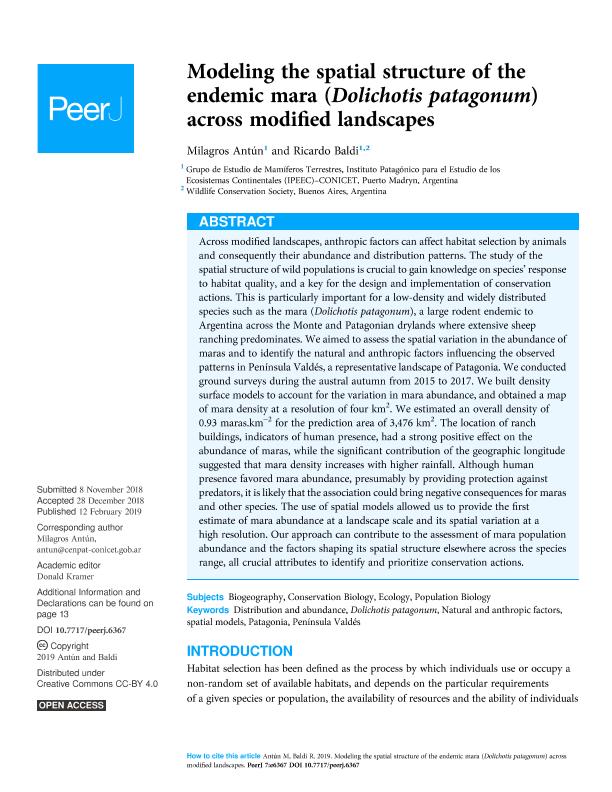Mostrar el registro sencillo del ítem
dc.contributor.author
Antun, Maria de Los Milagros

dc.contributor.author
Baldi, Ricardo

dc.date.available
2020-05-26T19:25:15Z
dc.date.issued
2019-02
dc.identifier.citation
Antun, Maria de Los Milagros; Baldi, Ricardo; Modeling the spatial structure of the endemic mara ( Dolichotis patagonum ) across modified landscapes; PeerJ; PeerJ; 7; 2-2019; 1-18
dc.identifier.issn
2167-8359
dc.identifier.uri
http://hdl.handle.net/11336/105920
dc.description.abstract
Across modified landscapes, anthropic factors can affect habitat selection by animalsand consequently their abundance and distribution patterns. The study of thespatial structure of wild populations is crucial to gain knowledge on species? responseto habitat quality, and a key for the design and implementation of conservationactions. This is particularly important for a low-density and widely distributedspecies such as the mara (Dolichotis patagonum), a large rodent endemic toArgentina across the Monte and Patagonian drylands where extensive sheepranching predominates. We aimed to assess the spatial variation in the abundance ofmaras and to identify the natural and anthropic factors influencing the observedpatterns in Península Valdés, a representative landscape of Patagonia. We conductedground surveys during the austral autumn from 2015 to 2017. We built densitysurface models to account for the variation in mara abundance, and obtained a mapof mara density at a resolution of four km2. We estimated an overall density of0.93 maras.km-2for the prediction area of 3,476 km2. The location of ranchbuildings, indicators of human presence, had a strong positive effect on theabundance of maras, while the significant contribution of the geographic longitudesuggested that mara density increases with higher rainfall. Although humanpresence favored mara abundance, presumably by providing protection againstpredators, it is likely that the association could bring negative consequences for marasand other species. The use of spatial models allowed us to provide thefirstestimate of mara abundance at a landscape scale and its spatial variation at ahigh resolution. Our approach can contribute to the assessment of mara populationabundance and the factors shaping its spatial structure elsewhere across the speciesrange, all crucial attributes to identify and prioritize conservation actions
dc.format
application/pdf
dc.language.iso
eng
dc.publisher
PeerJ
dc.rights
info:eu-repo/semantics/openAccess
dc.rights.uri
https://creativecommons.org/licenses/by/2.5/ar/
dc.subject
DISTRIBUTION AND ABUNDANCE
dc.subject
DOLICHOTIS PATAGONUM
dc.subject
NATURAL AND ANTHROPIC FACTORS
dc.subject
SPATIAL MODELS
dc.subject
PATAGONIA
dc.subject
PENINSULA VALDES
dc.subject.classification
Conservación de la Biodiversidad

dc.subject.classification
Ciencias Biológicas

dc.subject.classification
CIENCIAS NATURALES Y EXACTAS

dc.title
Modeling the spatial structure of the endemic mara ( Dolichotis patagonum ) across modified landscapes
dc.type
info:eu-repo/semantics/article
dc.type
info:ar-repo/semantics/artículo
dc.type
info:eu-repo/semantics/publishedVersion
dc.date.updated
2020-05-19T18:35:09Z
dc.journal.volume
7
dc.journal.pagination
1-18
dc.journal.pais
Estados Unidos

dc.conicet.avisoEditorial
This is an open access article distributed under the terms of the Creative Commons Attribution License, which permits unrestricted use, distribution, reproduction and adaptation in any medium and for any purpose provided that it is properly attributed. For attribution, the original author(s), title, publication source (PeerJ) and either DOI or URL of the article must be cited.
dc.description.fil
Fil: Antun, Maria de Los Milagros. Consejo Nacional de Investigaciones Científicas y Técnicas. Centro Científico Tecnológico Conicet - Centro Nacional Patagónico. Instituto Patagónico para el Estudio de los Ecosistemas Continentales; Argentina
dc.description.fil
Fil: Baldi, Ricardo. Consejo Nacional de Investigaciones Científicas y Técnicas. Centro Científico Tecnológico Conicet - Centro Nacional Patagónico. Instituto Patagónico para el Estudio de los Ecosistemas Continentales; Argentina
dc.journal.title
PeerJ
dc.relation.alternativeid
info:eu-repo/semantics/altIdentifier/url/https://peerj.com/articles/6367
dc.relation.alternativeid
info:eu-repo/semantics/altIdentifier/doi/http://dx.doi.org/10.7717/peerj.6367
Archivos asociados
